All you need to know about your products!

| 3DNews Vendor Reference English Resource - All you need to know about your products! |
||||||
 |
||||||
|
|
||||||
Foxconn 9800GTX – "change of clothes"Author:Date: 11/04/2008 The NVIDIA G92 graphic processor has proved really successful and given birth to a number of models of video cards. G92 made its debut in GeForce 8800GT where it was in its "cut-down" form. Then, there appeared the "full-featured" GeForce 8800GTS 512 and even more "cut down" GeForce 8800GS, at which the capabilities of the new GPU seemed to have been exhausted. But its career only started at that. The next "job" of the new chip was GeForce 9800GX2, and now the graphic processor has migrated into GeForce 9800GTX. Judging by the name, the new product has come to replace GeForce 8800GTX video cards which were laid off production early in 2008. Perhaps that is why GeForce 9800GTX has been equipped with a "dual" connector to operate in the 3-way SLI combination - otherwise, how can it be a replacement if the predecessor was able to do that? Besides, the new video card has turned cheaper to manufacture, so there are more than enough reasons for NVIDIA to release it. You can compare the specifications of GeForce 9800GTX versus those of other video cards based on G92 from the below table.
As you can see, GeForce 9800GTX does not make much difference from the cheaper GeForce 8800GTS 512. Now let's take a closer look at the new product. In our today's review, we are having the overclocked Foxconn GeForce 9800GTX.  To all appearances, the front side of the box demonstrates the dignity of the contents. Some inspiring god with the arms stretched upwards and a whole heap of awards from varied sites indicate that. In fact, the list of awards on the front side is not yet finishing. 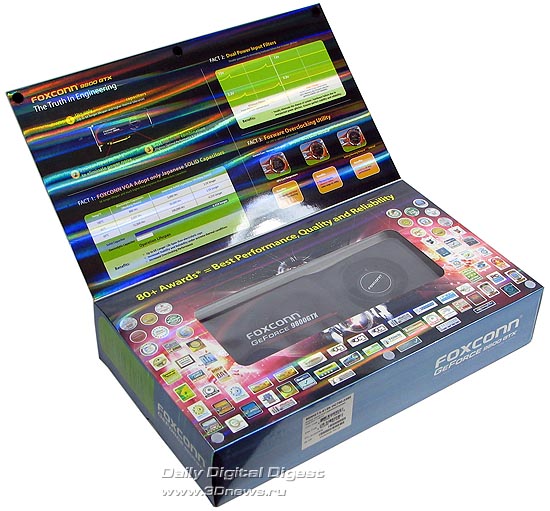 The box can be opened up like a book. The list of awards acquired by the manufacturer goes on inside. There is also a space for other advantages of the video card, to be more precise, the technologies implemented in it. By the way, the video card can be watched through a special small window.  The reverse side of the box tells a bit about the SLI technology and other NVIDIA's proprietary technologies.  The package bundle of Foxconn 9800GTX is rather sensible:
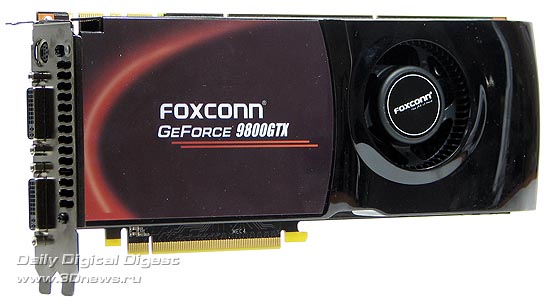  Foxconn 9800GTX has proved to be rather large, or long. At that, the new product is able competing against the monsters like GeForce 8800GTX/Ultra or Radeon HD3870 X2. 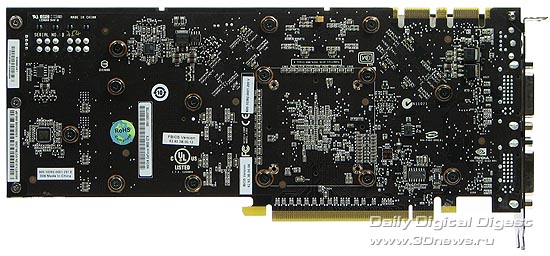 On the reverse side, you can see the "dual" SLI connector, the same as that on GeForce 8800GTX/Ultra video cards.  The same connector allows merging three video cards using a special bridge into an SLI trio. 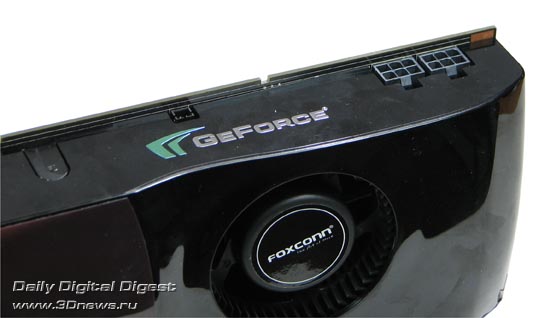 In the tail part of the video card, there are two 6-pin power connectors to apply S/P-DIF sound signal.  Near the DVI connectors or, to be precise, near the screw, there is a power indicator of the video card.  The video card is of NVIDIA's customary design. The cooling system is made almost completely of aluminum, with merely a pad for the graphic chip and the heat pipes made of copper.  Under the plastic housing there are three heat pipes soldered to the copper insert, with aluminum plates strung on them. The resultant structure is blown with a fan, with hot air expelled outside the CPU housing. 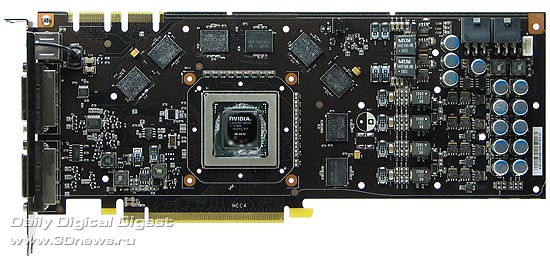 The PCB of Foxconn 9800GTX does not make much difference from that of GeForce 8800GTS 512. In the center of the board, there is the GPU NVIDIA G92 with 128 active universal processors as it was in the predecessor. In semi-circle around it, there are eight video memory chips making up 512 MB altogether. But despite the graphic processor similar to that of GeForce 8800GTS 512, the new product has noticeably grown in size.  The cause of that is the power supply subsystem which has grown complicated versus that of GeForce 8800GTS 512. Judging by the number and type of throttles, the GPU has acquired four power supply phases versus three in the predecessor, and the number of feed phases of the video memory has grown up to two versus one in GeForce 8800GTS 512. Such complications have allowed the video card to run stably at greater frequencies, although that is not an axiom.  The graphic processor has the G92-420 marking and belongs to revision 2. Recall that the chip in GeForce 8800GTS 512 is marked as G92-400. The figure in this case defines the purpose of the chip, and in our case the figure "420" points to GeForce 9800GTX. 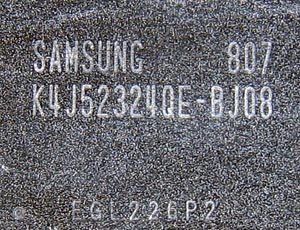 The memory chips are made by Samsung and offer 0.8 ns access time, which is equivalent to the effective clock speed 2400 MHz. The rated operating frequency is a bit lower, but we'll talk about that in the next part of the review. Now we move on to the next part. Efficiency of the cooling system and overclockingHowever formidable the cooling system may look, it anyway is not a guarantee of its high efficiency. In any case, we can judge about the operation quality of the product under review - almost the same cooling system is used in GeForce 8800GTS 512, two of which were reviewed formerly. But.. enough of words. Let's try it in action. We'll be warming up the video card with the game Oblivion set to the maximum quality. We produced the following results:  Foxconn 9800GTX warmed up to 68 C from 58 C at rest, and the cooling system remained quiet. Needless to say - the cooling system is good, and coupled with the improved power supply subsystem it should favor better overclocking of the video card. However, as it often happened before, the good cooling system and the power supply subsystem have not brought outstanding overclocking results to Foxconn 9800GTX. From the nominal 783/1890 MHz for the graphic processor and 2344 MHz for the video memory which are substantially higher than those recommended by NVIDIA, Foxconn 9800GTX was able to overclock from 756/1944 and 2504 MHz for the graphic processor and the video memory, respectively. The result for overclocking the video memory is impressive, however, that is merely 104 MHz above the nominal frequency of such memory with the access time 0.8 ns. On the other hand, we even had to reduce one of the frequencies of the GPU from 783 MHz to 756 MHz, because otherwise the video card was losing its stability with the increase in the frequency of the shader domain (a block of universal processors). The major "trump" of the new product is support for the "triple" SLI. Presumably, the lifespan of the new product is not long enough, so collectors will be pleased. Now let's see how fast the video card is. Move on to the tests. Test results and conclusionsWe'll be testing Foxconn 9800GTX on a test bench of the following configuration:
As contenders to Foxconn 9800GTX, we chose the "regular" GeForce 9800GTX running at the frequencies recommended by NVIDIA, and GeForce 8800 Ultra which despite its advanced age is still one of the most powerful single-GPU video cards to date. For tests, we used drivers of the following versions:
Traditionally, we are examining the test results starting with 3DMark tests. 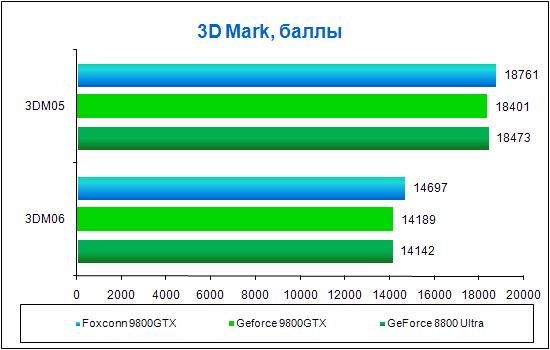 At this test, all the video cards scored about the same number of points; however, Foxconn 9800GTX proved to be the strongest. Now let's move on to gaming tests and see how the alignment of forces will change. We'll be running all the further tests with 4X FSAA and 16X AF.  At Call of Duty 4, Foxconn 9800GTX has scored only the second and left much behind GeForce 8800 Ultra. That's no good because the closest relative of the now product - GeForce 8800GTS 512 - ranked much higher than that. Now let's see how the new product with the old ForceWare 169.21 drivers will rank. Since they don't support GeForce 9800GTX, we'll set it as GeForce 8800GTS 512:  The video card ran without issues, but the old drivers cut down the rotational speed of the fan of the cooling system. To prevent overheating, we set an external 120 mm fan to blowing the video card. 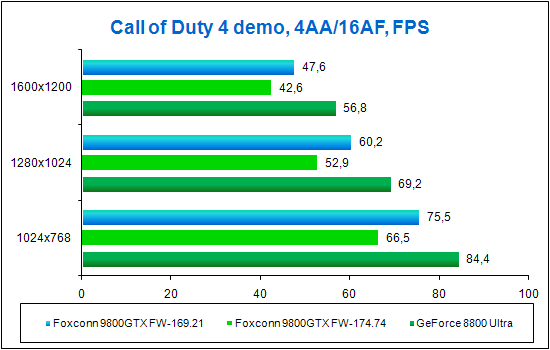 In the end, the speed performance at Call of Duty 4 has gone up, and we see a visual example of driver degradation on migration to the next version. 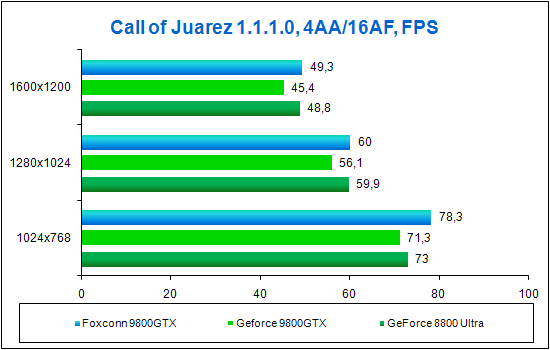 At Call of Juarez, Foxconn 9800GTX has proved to be faster than the others, including GeForce 8800 Ultra, so the new product has proved successful. 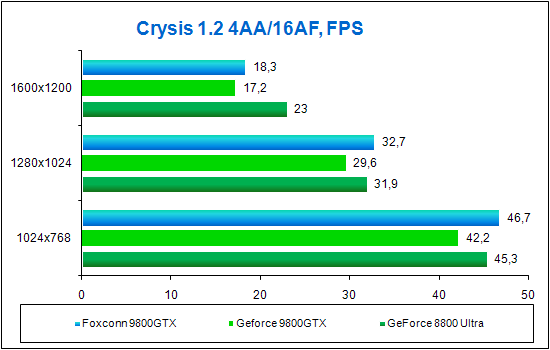 At Crysis, the new video cards has anyway yielded to GeForce 8800 Ultra, but only at 1600x1200. The narrower 256-bit memory bus versus the 384-bit in GeForce 8800 Ultra makes itself felt. 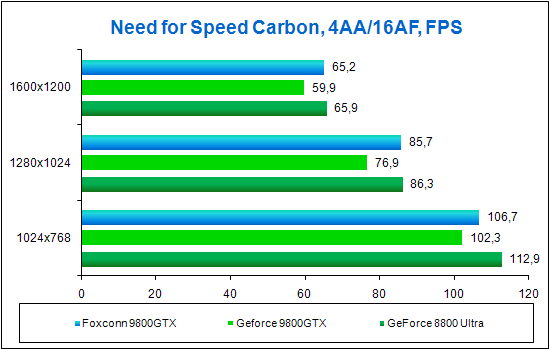 At Need for Speed Carbon, Foxconn's new product performs almost on par with GeForce 8800 Ultra. 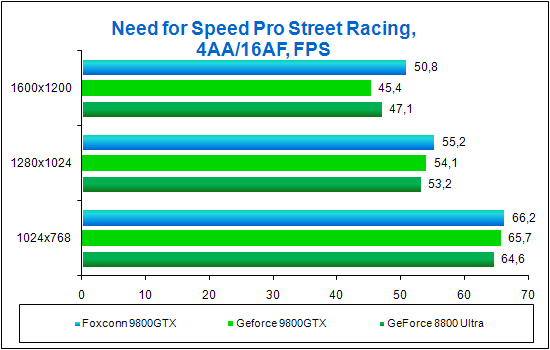 At Need for Speed Pro Street Racing, the rivals perform about on par at 1024x768 and 1280x1024, however at 1600x1200 Foxconn's new product anyway grabbed the leadership crown and took a lead over both the contenders. 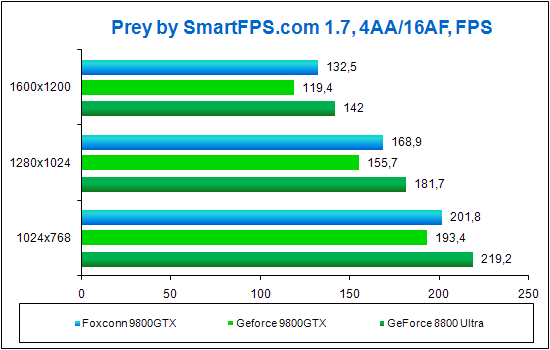 At Prey, Foxconn 9800GTX and GeForce 9800GTX are losing to GeForce 8800 Ultra. There is no wonder about that because Prey is sensitive to the memory bandwidth which is higher in GeForce 8800 Ultra with its wider 384 bit versus GeForce 8800GTX whose memory bus width is 256 bit. 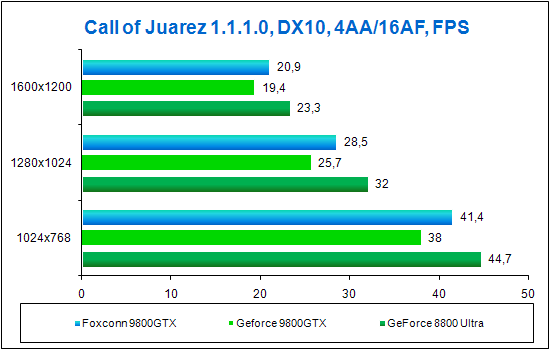 At Call of Juarez under Windows Vista, Foxconn 9800GTX ranked second after GeForce 8800 Ultra. The result is expectable, and it is really surprising to see that Foxconn 9800GTX and GeForce 9800GTX demonstrated a good result at 1600x1200. Do you remember that formerly 512 MB NVIDIA's video cards suffered from shortage of video memory in such modes under Windows Vista? Now let's check that through installation of old ForceWare 169.25 drivers on the new product and compare.  Quite expectable - with the old drivers, Foxconn 9800GTX "drowned" at 1600x1200, whereas with new drivers it "keeps afloat". Of course, no video memory capacity has gone up - simply, programmers at NVIDIA optimized its operation. By the way, what we have seen shows that NVIDIA is soon releasing updated drivers for all of its video cards and not only for GeForce 9800GTX. 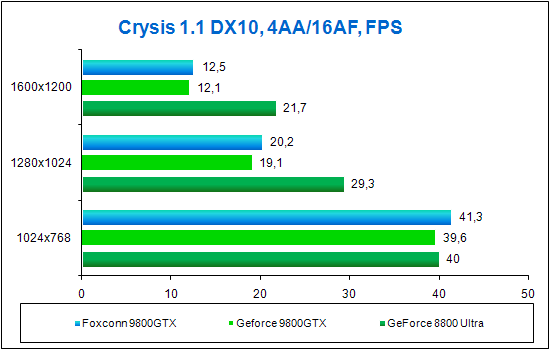 But at Crysis the pattern is not so optimistic. While at 1024x768 the Foxconn 9800GTX takes a lead over both its rivals, at 1280x1024 and 1600x1200 its performance drops down significantly. Perhaps, the video memory capacity lower than that in GeForce 8800 Ultra makes itself felt. Now let's see how Foxconn 9800GTX behaves with the old drivers. 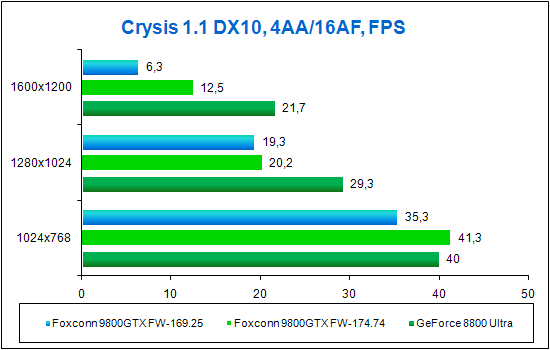 As you can see, with the old drivers the new product is not only slower but even less sensitive to the video memory capacity. At 1600x1200, the new product demonstrates twice as low a result with the old drivers installed! Final WordsFoxconn 9800GTX and GeForce 9800GTX in general has aroused ambiguous opinions. On the one hand, the new product has proved fast and cool, and on the other hand, it almost has not surpassed GeForce 8800GTX 512 with the price being much higher. To be more precise, GeForce 9800GTX can be referred to as GeForce 8800GTS 512 with support for 3-way SLI, so they will primarily of interest to those who is planning to build a "Tripartite Alliance" of video cards inside the computer. However, according to rumors, the new video cards are not going to be produced for long, so in any case they will find their owners.
- Discuss the material in the conference
|
||||||||||||||||||||||||||||||||||||||||||||||||||||||||||||||
|
|||||